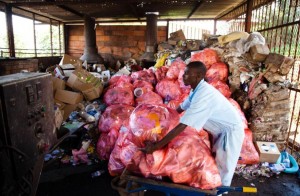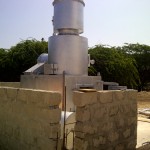
|
|
|
|
Items/Model |
TS100(PLC) |
|
TS150(PLC) |
TS300(PLC) |
|
TS500(PLC) |
Burn Rate (Average) |
|
100 kg/hour |
150 kg/hour |
|
300 kg/hour |
500 kg/hour |
|
Control Mode |
PLC Auto. |
|
PLC Auto. |
PLC Auto. PLC Auto. Combustion Chamber 1200L 1500L |
|
2000L |
3000L Internal Dimensions |
|
120x100x100cm |
150x100x100cm |
|
170x120x100cm |
210x120x120cm Secondary Chamber 600L |
|
750L |
1000L 1500L Smoke Filter Chamber |
|
Dry Scrubber |
Dry Scrubber |
|
Dry Scrubber |
Dry Scrubber |
|
Feed Mode |
Manual Manual Manual |
|
Manual |
Voltage |
|
220V |
220V |
|
220V |
220V Power |
|
1.38Kw |
1.69Kw 2.57Kw 4.88Kw |
|
Diesel Oil Consumption (kg/hour) |
Ave.20.4 Ave.24.2 Ave.33 |
|
Ave.44 |
Natural Gas Consumption (m3n/hour) Ave.24.5 Ave.29 Ave.39.6 |
|
Ave.52.8 |
Infection Monitor

|
Yes |
Yes |
Yes |
Yes |
Temperature Protection |
|
Yes |
Yes |
Yes |
Yes |
Oil Tank |
|
200L |
300L |
500L |
500L |
Feed Door |
|
80x60cm |
80x60cm |
|
|
Chimney |
|
10Meter |
10Meter |
14Meter |
14Meter |
Chimney Form |
|
Stainless Steel |
Stainless Steel |
Stainless Steel |
Stainless Steel |
1st. Chamber Temperature |
|
800℃–1000℃ |
800℃–1000℃ |
800℃–1000℃ |
800℃–1000℃ |
2nd. Chamber Temperature |
|
1000℃-1200℃ |
1000℃-1200℃ |
1000℃-1200℃ |
1000℃-1200℃ |
Residency Time |
|
2.0 Sec. |
2.0 Sec. |
2.0 Sec. |
2.0 Sec. |
Gross Weight |
|
6000kg |
8500kg |
11000kg |
16000kg |
External Dimensions |
|
260x150x180cm |
300x160x190cm |
400x210x300cm |
450x210x300cm |
|
|
|
|
|
|
|
|
2020-07-27 |
Three Combustion Chambers(Optional) |
3 Ranked for high risk waste |
Pet Cremation Equipment |
For Pet(small/big) Cremation Business |
|
Animal Incineration Equipment |
For other animal incineration |
General Waste Incinerator |
For MSW |
Mobile Incinerator(Optional) |
|
Small-Middle scale, cellular function by |
1. ) Wheel |
2.) DC-Power Trolley |
3.) Containerized |
Wet Scrubber for Smoke Filter(Optional) |
|
1. ) 1 Section Wet Scrubber |
2.) 3 Fragrant Wet Scrubber |
1 Section Wet Scrubber |
S.S304 Cooling Spray tower |
3 Sections Wet Scrubber |
|
1.) S.S304 Dust Scrubber |
3.) Front/Side Manual Loading |
2.) Top Feeding Door(Optional) |
3.) Auto. Feeding Door(Optional) |
3rd Combustion Chamber(Optional) |
|
|
Stainless Steel Main Body(Optional) |
S.S201 or S.S304 |
Control Model |
1.) Electric control box(Semi-automatic) |
|
2.) PLC Auto.control box(Automatic) |
|
Light Weight Upgrade(Optional) |
|
W2E(Waste to Energy)(Optional) |
|
Hot Water(Non-drinking water) |
Fuel Burner |
Italy Baltur Brand |
4.) Both D.O and N.G/LPG(not 2in1 burner, swap burner kind ) |
Temperature Thermocouple |
|
1.) K Type,Stainless Steel 1300(Standard) |
2.) K Form,Corundum 1300(Optional) |
3.) S Form,Platinum Rhodium 1600(Optional) |
Control Case Material |
1.) Steel (Conventional ) |
|
2.) Stailess Steel(Optional) |
|
Chimney/Stack |
1.) Stailess Steel (Standard) |
2.) Steel(Optional) |
|
3.) Length(Optional) |
4.) Thickness(Optional) |
|
400x210x300cm |
450x210x300cm |
Email: [email protected]
2020-07-27










